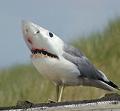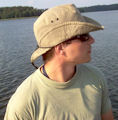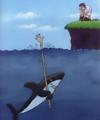i am lucky enough to get a seat out with some lads shark fishing off loop head next saturday.
Apparently the boat
got 2 specimen blues (unclaimed) and a specimen red gurnard yesterday! can't sleep worrying about hook choice,
haven't been able to make my mind up since a conversation with petekd and mohawk last year.
on left is maruto 230nsr 10/0, seems *very* sharp, small, but isn't a circle hook,
next is owner 10/0 circle hook which i use a lot now. i've got an 80lb on it but it seems
to bend when you pull it, maybe not strong enough?
on right is the standard 3407 hook and below the 39960D 14/0
any advice?
shark hook advice?
Moderator: JimC
-
jw

- SAI Megalodon!
- Posts: 1170
- Joined: Sun Jul 02, 2006 7:48 pm
- Location: dublin
- Has thanked: 4 times
- Been thanked: 80 times
shark hook advice?
You do not have the required permissions to view the files attached to this post.
-
MAC

- SAC Treasurer
- Posts: 4331
- Joined: Tue Jun 29, 2004 1:47 pm
- Location: Too far from Water
- Has thanked: 141 times
- Been thanked: 150 times
Re: shark hook advice?
Hi John,
New to sharking myself, but if it were me, I would be looking at 2 options.
Pennel Rig with 2 x maruto 230nsr 10/0. first hook in the mouth and second just behind the Dorsal fin of your bait. Pennels can be handy if the sharks are dropping baits a lot. Hit them early with a Pennel Rig and you might get a better hook up ratio. Pennel Rigs would be standard with an early strike in SA and these guys do seem to get a high hook up rate.
My other choice would be a Single owner 10/0 circle hook mounted just behind the head (inline with the pertorial fins). This setup I use a lot for Tope.
Just my 2c as they say.
Kev
New to sharking myself, but if it were me, I would be looking at 2 options.
Pennel Rig with 2 x maruto 230nsr 10/0. first hook in the mouth and second just behind the Dorsal fin of your bait. Pennels can be handy if the sharks are dropping baits a lot. Hit them early with a Pennel Rig and you might get a better hook up ratio. Pennel Rigs would be standard with an early strike in SA and these guys do seem to get a high hook up rate.
My other choice would be a Single owner 10/0 circle hook mounted just behind the head (inline with the pertorial fins). This setup I use a lot for Tope.
Just my 2c as they say.
Kev
><º> ><º>
><º>
><º>
-
Tomaszek

- SAI Hammerhead
- Posts: 332
- Joined: Wed Feb 14, 2007 9:52 pm
- Favourite Reel: Shimano
- Favourite Fish: Caranx hippos
- Location: Co. Kerry
- Has thanked: 2 times
- Been thanked: 6 times
Re: shark hook advice?
I was thinking about trying circle hooks myself. Still decided to stick with standard 9/0 hooks for 2009 season.
You do not have the required permissions to view the files attached to this post.
Tommy
[size=84]It's better to regret something you have done than something you haven't done[/size]
[size=84]It's better to regret something you have done than something you haven't done[/size]
-
Dave Jolly

- SAI Hammerhead
- Posts: 282
- Joined: Fri Oct 27, 2006 11:29 pm
- Location: cork
- Been thanked: 21 times
Re: shark hook advice?
I have used the owners a lot in the florida keys, they are too light for the sharks around at the moment, we were out on sunday and had 6 blues up to c.140lb, all hooked in the mouth, none deep hooked, using cox & Rawle 10/0 meat hooks, chemically sharpened, lock the drag and lean into the fish as soon as it starts to run, if you miss it will still be mooching around the slick, and will come back, much better than waiting to strike and potentially gut hooking the fish.
I have had bull sharks around 225lbs on the meat hooks, not a bother to them.
The gape on the Mustad is too small, and you would need to look at the 16/0 version, and baiting up would need to be very carefully done to avoid the bait bunching up and closing the gape even more.
Just my 2c worth.
I have had bull sharks around 225lbs on the meat hooks, not a bother to them.
The gape on the Mustad is too small, and you would need to look at the 16/0 version, and baiting up would need to be very carefully done to avoid the bait bunching up and closing the gape even more.
Just my 2c worth.
World Champion Gold Medals are the new Black!!!
-
MAC

- SAC Treasurer
- Posts: 4331
- Joined: Tue Jun 29, 2004 1:47 pm
- Location: Too far from Water
- Has thanked: 141 times
- Been thanked: 150 times
Re: shark hook advice?
Dave Jolly wrote:lock the drag and lean into the fish as soon as it starts to run,
Doing this nearly all the time for my Tope fishing Dave.
Kev
><º> ><º>
><º>
><º>
-
jw

- SAI Megalodon!
- Posts: 1170
- Joined: Sun Jul 02, 2006 7:48 pm
- Location: dublin
- Has thanked: 4 times
- Been thanked: 80 times
Re: shark hook advice?
thanks for interesting advice, came across this research
http://www.marinebiodiversity.ca/shark/ ... 0CJFAS.pdf
http://www.marinebiodiversity.ca/shark/ ... skull2.htm
which suggests about 33% of gut hooked or injured sharks die after release,
hence my preference for circle hooks, though i'm not sure of the strength of the
owner model i have been using
pennel might give a better catch rate but its a bitch of a job to get even one hook out of
a struggling shark sometimes
find the circle very effective for tope, ling etc
http://www.marinebiodiversity.ca/shark/ ... 0CJFAS.pdf
http://www.marinebiodiversity.ca/shark/ ... skull2.htm
which suggests about 33% of gut hooked or injured sharks die after release,
hence my preference for circle hooks, though i'm not sure of the strength of the
owner model i have been using
pennel might give a better catch rate but its a bitch of a job to get even one hook out of
a struggling shark sometimes
find the circle very effective for tope, ling etc
-
jw

- SAI Megalodon!
- Posts: 1170
- Joined: Sun Jul 02, 2006 7:48 pm
- Location: dublin
- Has thanked: 4 times
- Been thanked: 80 times
Re: shark hook advice?
Satellite transmitters and hooking mortality
Most of the blue sharks caught in the North Atlantic are caught accidentally during commercial fishing operations for species such as swordfish and tuna. Almost all of the blue sharks are released at sea (including the 20% that are already dead), but scientists around the world currently assume that many of the remainder die after release. The exact proportion that die is unknown, but this number is important: if most of the released sharks survive, there is no great problem. But if most die after release, bycatch mortality may be the major cause of the observed population decline.
To determine the mortality rate of blue sharks caught and released in the commercial and recreational fishery, archival satellite pop-up tags have been applied to a small percentage of the sharks caught during normal commercial and sport fishing operations. These computerized tags record the depth and temperature of the water every few minutes, and thus record any evidence of death (sinking to the ocean bottom or floating to the surface). At a pre-programmed date (usually 3-6 months after tagging), the tag releases from the shark, floats to the ocean surface, and then transmits all of the stored data to an orbiting satellite. The data is then sent to our lab, where we determine the location and swimming history of the shark as well as whether or not it died.
Our research indicated that overall blue shark bycatch mortality in the pelagic longline fishery was 35%, while the estimated discard mortality for sharks that were released alive was 19%. All healthy sharks survived, while 33% of those that were badly injured or gut hooked subsequently died. Survival time models indicated that 95% of the mortality occurred within 11 d of release, indicative of death by trauma rather than starvation. The annual blue shark catch in the North Atlantic was estimated at about 84 000 t, of which 57 000 t is discarded. A preliminary estimate of 20 000 t of annual dead discards for North Atlantic blue sharks is similar to that of the reported nominal catch, and could substantially change the perception of population health if incorporated into a population-level stock assessment. This work has been published (Campana et al. 2009).
Click on the images below to see blue sharks being tagged with satellite tags (Note: these are high resolution images, so they may take somewhat longer to display).
Most of the blue sharks caught in the North Atlantic are caught accidentally during commercial fishing operations for species such as swordfish and tuna. Almost all of the blue sharks are released at sea (including the 20% that are already dead), but scientists around the world currently assume that many of the remainder die after release. The exact proportion that die is unknown, but this number is important: if most of the released sharks survive, there is no great problem. But if most die after release, bycatch mortality may be the major cause of the observed population decline.
To determine the mortality rate of blue sharks caught and released in the commercial and recreational fishery, archival satellite pop-up tags have been applied to a small percentage of the sharks caught during normal commercial and sport fishing operations. These computerized tags record the depth and temperature of the water every few minutes, and thus record any evidence of death (sinking to the ocean bottom or floating to the surface). At a pre-programmed date (usually 3-6 months after tagging), the tag releases from the shark, floats to the ocean surface, and then transmits all of the stored data to an orbiting satellite. The data is then sent to our lab, where we determine the location and swimming history of the shark as well as whether or not it died.
Our research indicated that overall blue shark bycatch mortality in the pelagic longline fishery was 35%, while the estimated discard mortality for sharks that were released alive was 19%. All healthy sharks survived, while 33% of those that were badly injured or gut hooked subsequently died. Survival time models indicated that 95% of the mortality occurred within 11 d of release, indicative of death by trauma rather than starvation. The annual blue shark catch in the North Atlantic was estimated at about 84 000 t, of which 57 000 t is discarded. A preliminary estimate of 20 000 t of annual dead discards for North Atlantic blue sharks is similar to that of the reported nominal catch, and could substantially change the perception of population health if incorporated into a population-level stock assessment. This work has been published (Campana et al. 2009).
Click on the images below to see blue sharks being tagged with satellite tags (Note: these are high resolution images, so they may take somewhat longer to display).
-
petekd

- SAI Megalodon!
- Posts: 4840
- Joined: Fri May 06, 2005 5:46 pm
- Favourite Rod: ZZiplex GB3 Lite
- Favourite Reel: 7ht Mag
- Favourite Fish: Big fat botties
- Location: Cork
- Has thanked: 29 times
- Been thanked: 91 times
Re: shark hook advice?
That whole stomach regurgitation thing they do occasionally concerns me somewhat. I cant possibly see how the poor old fish can survive that. Does anyone have anymore info on it at all?
Fluff chucking is the new black..... Rampant Wreckfish is a fly angler in denial 